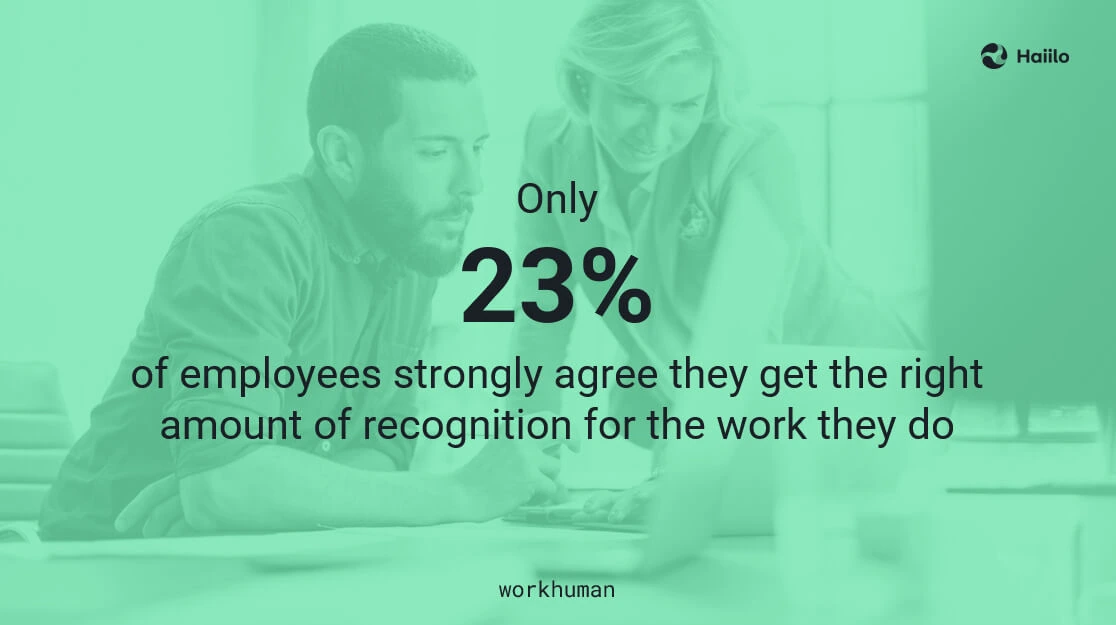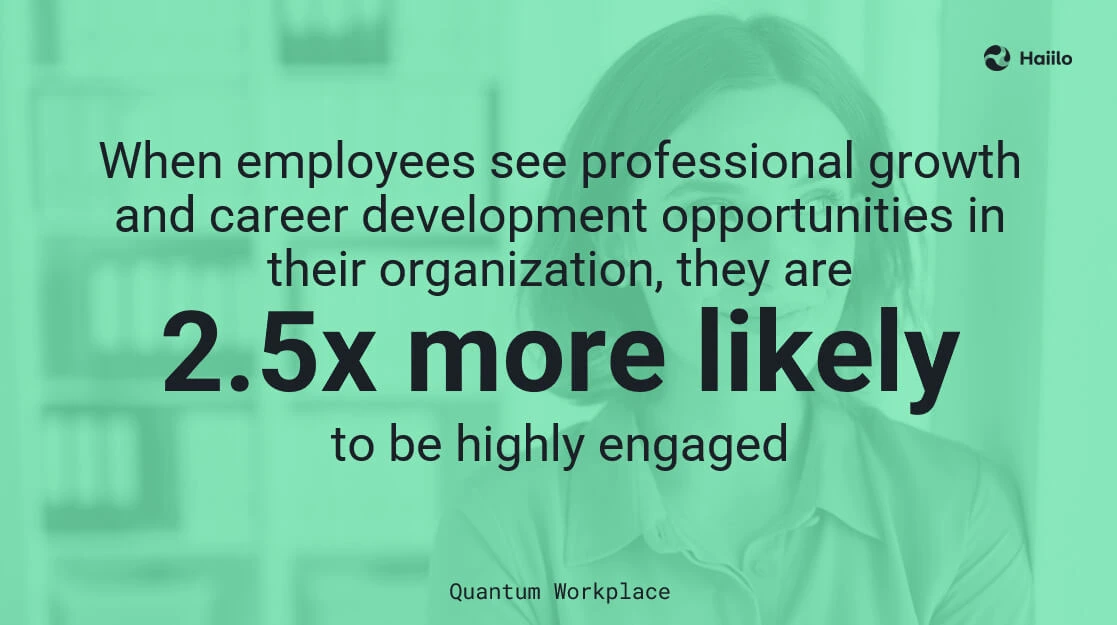Improving employee satisfaction is on the list of the top three KPIs in every organization’s human resources department. Moreover, many companies now require managers to own this KPI, as managers are responsible for the biggest variance in employee engagement and satisfaction.
However, other departments such as internal communications, IT departments, and even legal and finance departments play their role in shaping a positive employee experience in the workplace.
So what can your organization do to improve employee satisfaction and boost employee motivation at work?
Keep reading to discover 12 ways you can make your employees happier, more productive, and more loyal.
- 1. Understand What Shapes Employee Experience
- 2. Focus on Communications and Organizational Alignment
- 3. Eliminate Organizational Silos
- 4. Encourage Acts of Gratitude
- 5. Enable Managers to Measure Employee Satisfaction
- 6. Invest in DEI Initiatives
- 7. Offer Career Progression Opportunities
- 8. Appreciate Bottom-Up Feedback
- 9. Implement a Well-being Program
- 10. Improve Employee Onboarding
- 11. Benchmark Your Comp & Benefits
- 12. Pay Special Attention to Workplace Technology
1. Understand What Shapes Employee Experience
Too often, employers try to guess how to improve employee satisfaction. As a consequence, they invest in the wrong initiatives and see poor results and low impact.
Instead, you should first do your best to understand the current state of your workforce and define all the factors that shape their experience in your organization.
The most simple yet accurate way to do so is by sending out employee surveys. There are plenty of employee survey examples you can use to create a survey that best resonates with your company.
When distributing the survey, make sure that you reach as many employees as possible. Use various internal communications channels so that you generate as many responses as possible. Even as raw data, your survey solution should already give you valuable insights and actionable recommendations for improvement.
Improve your employees’ satisfaction with Haiilo communications platform!
2. Focus on Communications and Organizational Alignment
Internal communications departments play a critical role in improving employee satisfaction in the workplace. Since the emergence of the pandemic and remote work, IC professionals have become one of the most important strategic business partners.
They drive organizational alignment, distribute critical information to the right people at the right time, and motivate employees with internal storytelling, particularly when teams are not physically together in person.
When employees are aligned with the company’s ultimate goals and business objectives, they better understand their purpose at work and are naturally more satisfied with their jobs.
Furthermore, when they see that their employer practices transparency and openness, they are more likely to trust their employers and leadership teams.
Unfortunately, today, according to research, 52% of employees don’t know what their company’s vision is, and IBM found that 72% don’t fully understand their company’s strategy and what it takes to get there, including their own input.
📹 Check out our masterclass on Internal Comms in Your Business: It’s Importance and Best Practices
3. Eliminate Organizational Silos
Too many companies still work in silos, making it hard for employees to collaborate on projects and be productive. In fact, 55% of organizations work in silos and fight the negative sides daily. Working in silos obstructs communication, impacts employee engagement and productivity, and leads to a drop in employee morale and poor employee well-being.
On the other hand, companies that know how to break down cross-departmental silos are seeing much better employee satisfaction and performance.
To be more precise, organizations that move to cross-functional teams found that 53% experienced a significant improvement in performance, and 31% reported that most or almost all of their work was being done in teams.
4. Encourage Acts of Gratitude
Acts of gratitude and recognition are some of the best (and easiest) ways to boost employee satisfaction. People want to be recognized for what they do, especially if they go the extra mile to achieve great results. Great performance and the right workplace behaviors should never be neglected by managers and employers.
The new report found that only 23% of employees strongly agree they get the right amount of recognition for their work. At the same time, 36% of organizations with an employee recognition program have a huge leg up against their competition.

To get started, you can implement a simple, non-monetary recognition program. This can be as simple as creating an internal channel where employees can send kudos to each other. Social recognition not only boosts employee morale but also gives visibility about what kinds of actions and behaviors are expected in the workplace.
5. Enable Managers to Measure Employee Satisfaction
As mentioned earlier, managers and leaders play a critical role in driving higher employee satisfaction. So to enable your managers to do a better job, you need to equip them with the right technology to understand and measure their employees’ satisfaction on a regular basis.
Weekly pulse surveys are a simple and efficient way to do so.
Even though there are many survey solutions on the market, not many of them are designed to provide more than just raw data, leaving the managers without actionable plans for improvement.
Ideally, your survey technology should give you valuable insights and recommendations for improving your employee satisfaction in the workplace.
7. Offer Career Progression Opportunities
One of the biggest reasons for work dissatisfaction is the lack of career progression opportunities. When employees feel like they are stuck in their current positions and don’t see a path forward, they are likely to become demotivated to do their best.
According to research, employees who see professional growth and career development opportunities in their organization are 2.5x more likely to be highly engaged than those who do not.

This is why many companies have created formal career paths and are transparently communicating them to their employees. Employees know exactly what they need to achieve in order to move up the ladder.
8. Appreciate Bottom-Up Feedback
Historically, feedback in organizations was mostly one-directional. Meaning, managers were the only ones expected to provide feedback to their employees.
Today, employees expect to be able to always share their voice, raise concerns, and ask questions.
Unfortunately, according to research, only a quarter of employees feel like they can freely express themselves at work. One-quarter report that they often choose not to speak up at work, even though they have something they would like to say.
Just over 22% report high levels of expressing their voice to create and implement new ideas.
As a consequence, many employees still don’t speak about their concerns to anyone at work, resulting in lower employee satisfaction.
9. Implement a Well-being Program
There is a strong correlation between employee well-being and employee satisfaction dn engagement at work.
Gallup’s research that connects employee well-being with employee engagement found that employees who work at companies that invest in their well-being are:
- 42% more likely to evaluate their overall lives highly
- 27% more likely to report “excellent” performance in their own job at work
- 45% more likely to report high levels of adaptability in the presence of change
- 59% less likely to look for a job with a different organization in the next 12 months
Because poor work-life balance is often the biggest stress point in the workplace, your employee well-being program should focus on improving your employees’ work-life balance. Plenty of research has already proved that emotionally drained employees are less satisfied, less motivated, and less engaged to perform well.
10. Improve Employee Onboarding
Employee onboarding can make or break the level of satisfaction of your newly hired employees. Unfortunately, too many organizations still don’t have structured employee onboarding programs to help their people get started successfully.
Employers should have a single central content hub for their new hires and enable them to easily find all the information they need to get onboarded.
Employees should be able to reach out to any coworker and be able to easily access documents, files, and other materials relevant to their job.
11. Benchmark Your Comp & Benefits
All of the above-mentioned best practices can surely impact your employees’ job satisfaction. However, when employees are not happy with the way they are compensated for what they do, this is the first thing to address.
It is critical that you incentivize your employees for their hard work. This is the only way to maintain high engagement and productivity.
According to research, well-structured incentive programs can increase employee performance by as much as 44%. On the other hand, when employees feel like they are not compensated fairly, their morale drops, and they are less motivated to perform well.
12. Pay Special Attention to Workplace Technology
Last but not least, workplace technology is one of the biggest drivers for higher employee satisfaction.
According to research, investments in digital transformation will reach $2.8 trillion by 2025, and over 50% of people think technology will determine workplace changes in the next few years.
Another study by Ultimate Software found that 92% of workers said having technology that makes their jobs easier impacts their happiness with their jobs. In Qualtrics research, only 30% of employees said their experience with their company’s technology exceeds their expectations.
The same research showed that when employees are satisfied with their IT services and technology experience they are 158% more engaged at work.










